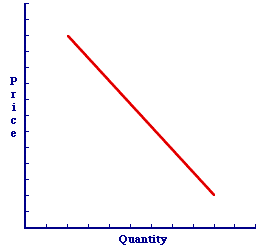
|
|
U-SHAPED COST CURVES: The family of short-run cost curves consisting of average total cost, average variable cost, and marginal cost, all of which have U-shapes. They are U-shaped because each has high but falling cost at low quantities of output, which then reaches a minimum, then has rising cost at larger quantities of output. Although the average fixed cost curve is not U-shaped, it's occasionally included with the other three just for sake of completeness.
Visit the GLOSS*arama
|
|


|

|
                           CHANGE IN DEMAND: A shift of the demand curve caused by a change in one of the demand determinants. A change in demand is caused by any factor affecting demand EXCEPT price. A related, but distinct, concept is a change in quantity demanded. A change in demand is a change in the entire price-quantity relation that makes up the demand curve. It means that a different quantity demanded is paired with a given demand price or that a different demand price is paired with a given quantity demanded. The result of this repairing of prices and quantities is a repositioning, or a shift, of the demand curve.The five demand determinants (buyers' income, buyers' preferences, other prices, buyers' expectations, and number of buyers) are responsible for causing a change in demand. In fact, the only thing that DOES NOT cause a change in demand is the demand price. Demand and Quantity DemandedTo set the stage for an understanding of this difference, take note of two related concepts: - Demand: Demand is the range of quantities that buyers are willing and able to buy at a range of demand prices. It is ALL points that make up a demand curve.
- Quantity Demanded: Quantity demand is a specific quantity that buyers are willing and able to buy at a specific demand price. It is but ONE point on a demand curve.
Making ChangesSo what happens when the phrase "change in" is placed in front of each term?- Change in Demand: A change in demand is a change in the ENTIRE demand relation. This means changing, moving, and shifting the entire demand curve. The entire set of prices and quantities is changing. In other words, this is a shift of the demand curve. A change in demand is caused by a change in the five demand determinants.
- Change in Quantity Demanded: A change in quantity demanded is a change from one price-quantity pair on an existing demand curve to a new price-quantity pair on the SAME demand curve. In other words, this is a movement along the demand curve. A change in quantity demanded is caused by a change in price.
Changing Demand| A Change in Demand | 
|
A change in demand is a shift of the demand curve. A change in quantity demanded is a movement along a given demand curve. These alternatives can be illustrated with the negatively-sloped demand curve presented in this exhibit. This demand curve captures the specific one-to-one, law of demand relation between demand price and quantity demanded. The five demand determinants are assumed to remain constant with the construction of this demand curve.- A Change in Demand: A change in demand, which is triggered by a change in any of the five demand determinants, is a shift of the demand curve. Click the [A Determinant Change] button to demonstrate.
- A Change in Quantity Demanded: A change in quantity demanded, which is only triggered by a change in demand price, is a movement along the demand curve. Click the [A Price Change] button to demonstrate.
An Important DifferenceWhy is this difference so important? The answer is as simple as cause and effect. The demand curve is used (together with supply) to explain and analyze market exchanges. The sequence of events follows a particular pattern.- First, a demand (or supply) determinant changes.
- Second, this determinant change causes the demand curve (or supply curve) to shift.
- Third, the change in demand (or supply) causes either a shortage or a surplus imbalance in the market. The market is in a temporary state of disequilibrium.
- Fourth, the shortage and surplus imbalance causes the price of the good to change.
- Fifth, the change in price causes a change in quantity demanded (and supplied).
- Sixth, the change in quantity demanded (and supplied) eliminates the shortage or surplus and restores market equilibrium.
The key conclusion is that demand (and supply) determinants, which induce changes in demand (and supply), are the source of instability in the market. The change in price, which induces a change in quantity demanded (and supplied) is the means of eliminating the instability and restoring equilibrium.

Recommended Citation:CHANGE IN DEMAND, AmosWEB Encyclonomic WEB*pedia, http://www.AmosWEB.com, AmosWEB LLC, 2000-2024. [Accessed: May 16, 2024].
Check Out These Related Terms... | | | |
Or For A Little Background... | | | | | | | | | |
And For Further Study... | | | | | | | | | |
Search Again?
Back to the WEB*pedia
|



|

|
PURPLE SMARPHIN
[What's This?]
Today, you are likely to spend a great deal of time flipping through the yellow pages wanting to buy either a how-to book on the art of negotiation or a flower arrangement for your aunt. Be on the lookout for bottles of barbeque sauce that act TOO innocent.
Your Complete Scope
This isn't me! What am I?
|

|
|
A lump of pure gold the size of a matchbox can be flattened into a sheet the size of a tennis court!
|

|
|
"Try not to become a man of success but rather to become a man of value. " -- Albert Einstein
|

|
LSE
London Stock Exchange
|

|
|
Tell us what you think about AmosWEB. Like what you see? Have suggestions for improvements? Let us know. Click the User Feedback link.
User Feedback
|


|


